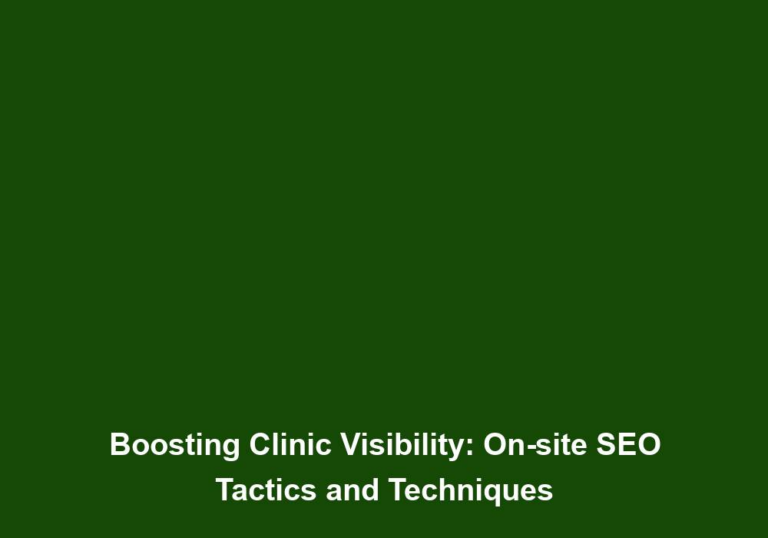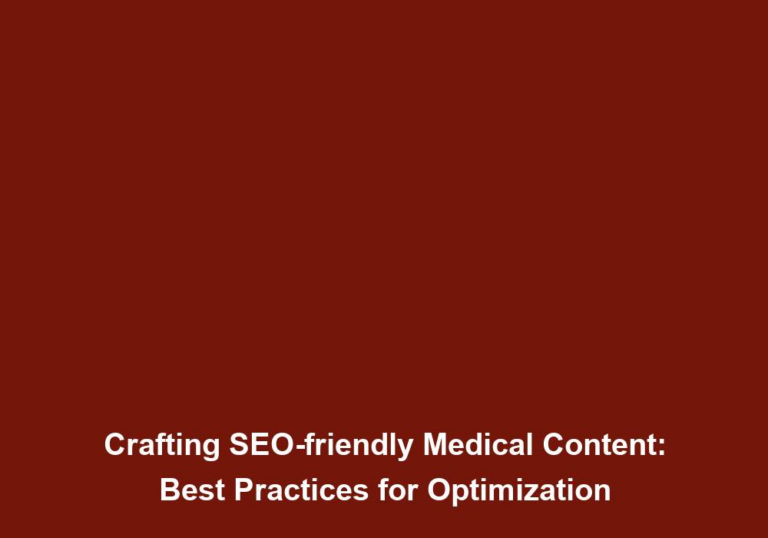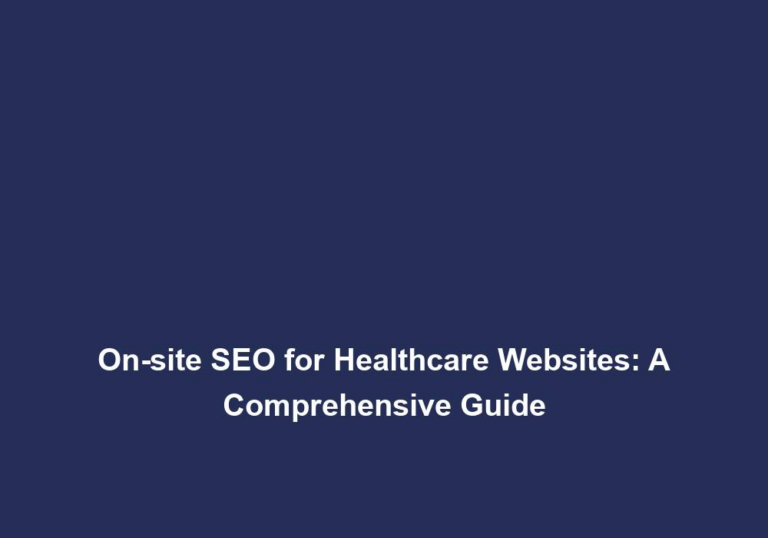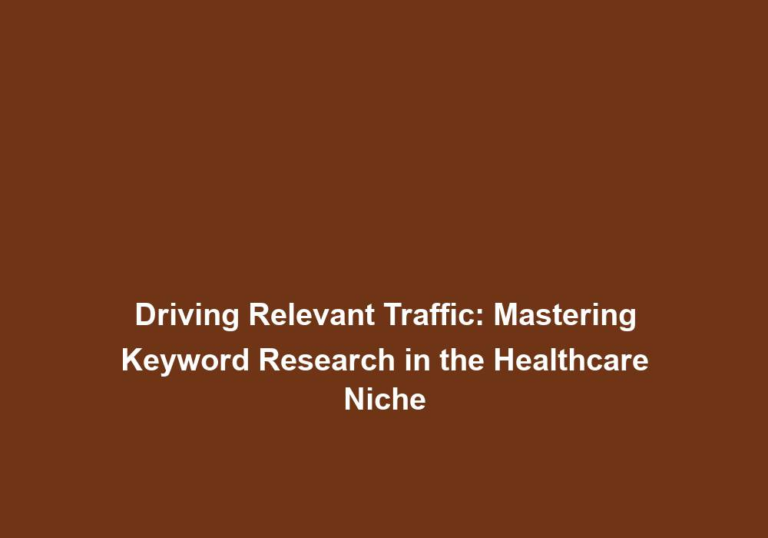Ensuring Patient Engagement: On-site Medical Content Optimization Strategies
In today’s digital age, it is essential for healthcare providers and medical professionals to prioritize patient engagement on their websites. With the increasing reliance on online platforms for health-related information, optimizing on-site medical content has become crucial to attract and retain patients. In this article, we will explore effective strategies to ensure patient engagement through on-site medical content optimization.
1. Understand Your Target Audience
To effectively engage patients, it is vital to have a clear understanding of your target audience. Conduct thorough research to identify the demographics, preferences, and interests of your potential patients. By gaining insights into your target audience, you can tailor your medical content to meet their specific needs and expectations.
- Collect demographic information such as age, gender, location, and language preferences.
- Use surveys or feedback forms to understand patients’ preferences and interests.
- Analyze social media platforms and online forums to gather insights into common questions and concerns.
Understanding your target audience allows you to create content that resonates with them, making it more likely for them to engage with your website and services.
2. Perform Keyword Research
Keyword research forms the foundation of any successful content optimization strategy. Identify relevant keywords and phrases that your target audience is likely to search for when seeking medical information. Tools like Google Keyword Planner or SEMrush can assist you in finding commonly searched terms related to your medical niche.
- Use keyword research tools to identify high-volume and low-competition keywords.
- Consider long-tail keywords that are more specific and reflect patients’ search intent.
- Analyze competitor websites to uncover keywords they are targeting successfully.
By incorporating relevant keywords throughout your medical content, you can improve its visibility in search engine results, driving organic traffic to your website.
3. Craft Engaging and Informative Headlines
Compelling headlines are crucial to capture the attention of website visitors. Craft informative and engaging headlines that clearly communicate the benefits or value of the content. Incorporate target keywords into your headlines to optimize them for search engines as well.
- Use strong, action-oriented language to create compelling headlines.
- Address patients’ pain points or offer solutions to their problems.
- Keep headlines concise, but make sure they convey the main message effectively.
Well-crafted headlines not only attract visitors but also improve click-through rates, increasing the chances of patient engagement.
4. Create High-Quality and Well-Structured Content
When optimizing medical content, it is essential to focus on providing high-quality and valuable information. Ensure that your content is accurate, well-researched, and up-to-date. Structure your content into easy-to-read sections with subheadings to improve readability.
- Conduct thorough research and cite credible sources to maintain accuracy.
- Break content into sections with descriptive subheadings for easy navigation.
- Use bullet points, lists, and visuals to enhance readability and comprehension.
By delivering high-quality content that addresses patients’ concerns and provides valuable insights, you establish credibility and foster patient engagement.
5. Optimize Meta Tags and Meta Descriptions
Meta tags and meta descriptions play a vital role in search engine optimization (SEO) and can significantly impact click-through rates. Optimize your meta tags by incorporating relevant keywords and crafting concise and engaging meta descriptions that entice users to click on your website in search engine results.
- Include target keywords naturally in meta tags to improve visibility.
- Craft meta descriptions that provide a brief preview of the content and its benefits.
- Make meta tags and descriptions compelling and unique for each page.
Optimizing meta tags and descriptions not only improves search engine visibility but also entices users to click and engage with your medical content.
6. Incorporate Visual Elements
Visual elements such as images, infographics, and videos can enhance the overall user experience and make your medical content more engaging. Utilize relevant visuals to support your written content and convey complex medical concepts more effectively.
- Use high-quality images that are relevant to the topic.
- Create infographics to visually represent data or statistics.
- Embed videos that provide additional explanations or demonstrations.
Visual elements not only break up the text but also make the content more appealing, increasing patient engagement and understanding.
7. Implement Clear Call-to-Actions (CTAs)
To encourage patient engagement, it is crucial to include clear and compelling call-to-actions (CTAs) throughout your website. Whether it’s scheduling an appointment, subscribing to a newsletter, or accessing additional resources, well-placed CTAs can guide visitors towards desired actions and improve overall user engagement.
- Use action-oriented language in your CTAs to motivate patients.
- Place CTAs strategically within the content and make them visually prominent.
- Offer incentives or benefits to encourage users to take action.
Effective CTAs prompt patients to take the next step, leading to increased engagement and conversions.
8. Make Your Content Mobile-Friendly
With the increasing use of smartphones and tablets, it is paramount to optimize your medical content for mobile devices. Ensure that your website is responsive and mobile-friendly, allowing users to access and engage with your content seamlessly across different devices.
- Use responsive web design to adapt content layout to various screen sizes.
- Optimize images and videos for fast loading on mobile devices.
- Test the mobile-friendliness of your website using tools like Google’s Mobile-Friendly Test.
A mobile-friendly website ensures that patients can easily navigate and engage with your content, regardless of the device they are using.
9. Utilize Internal Linking
Internal linking is an effective strategy to keep users engaged and guide them to relevant information within your website. By linking related pages or blog posts, you can create a cohesive content structure, improve navigation, and encourage users to explore more of your medical content.
- Identify relevant pages or blog posts to link within your content.
- Use descriptive anchor text that accurately represents the linked content.
- Ensure that the internal links are natural and provide additional value to users.
Internal linking not only improves user experience but also helps search engines understand the structure and relevance of your medical content.
10. Monitor and Analyze User Engagement Metrics
Regularly monitor and analyze user engagement metrics to gain insights into the effectiveness of your content optimization strategies. Tools like Google Analytics can provide valuable data on page views, bounce rates, time spent on page, and conversion rates. Analyzing these metrics will help you identify areas for improvement and fine-tune your content strategy accordingly.
- Set up Google Analytics to track user engagement metrics on your website.
- Monitor page views and time spent on page to gauge content relevance and engagement.
- Analyze bounce rates and conversion rates to identify areas for improvement.
By continuously monitoring user engagement metrics, you can make data-driven decisions to optimize your medical content and further enhance patient engagement.
In conclusion, ensuring patient engagement through on-site medical content optimization is crucial for the success of healthcare providers and medical professionals. By understanding your target audience, performing keyword research, crafting engaging headlines, creating high-quality content, optimizing meta tags, incorporating visual elements, implementing clear CTAs, making your content mobile-friendly, utilizing internal linking, and monitoring user engagement metrics, you can maximize patient engagement and drive organic traffic to your website. Prioritize patient-centric content that provides value, builds trust, and empowers patients to make informed healthcare decisions.







